Star fruit, also known as Carambola, is a delicious tropical fruit that is grown in various regions around the world, including Thailand, Southeast Asia, Australia, South America, Hawaii, and Florida. It is highly favored for its unique shape and taste, making it a popular choice among fruit enthusiasts.
Have you ever wondered when is the perfect time to enjoy this delightful fruit? In this guide, we will delve into the question of when star fruit is ripe, so you can savor its tropical goodness at its prime.
When ripe, star fruit showcases a vibrant yellow color with hints of green, and can even have small brown spots along its ridges. Its flesh should be firm to the touch, indicating that it is ready to be enjoyed.
If you’re curious about star fruit ripeness, read on to find out more.
Key Takeaways:
- When star fruit is ripe, it is bright yellow with hints of green and may have brown spots along the ridges.
- The flesh of a ripe star fruit should be firm to the touch.
- Avoid overripe star fruit, which turns entirely yellow with brown spots.
- Green star fruit can ripen by leaving it on the counter until it turns yellow.
- Star fruit is a tropical treat that is rich in Vitamin C and adds a unique touch to various recipes and dishes.
What is Star Fruit?
Star fruit, also known as Carambola, is a part of the citrus family and is native to Southeast Asia. It comes in two main varieties: sour and sweet. The fruit is yellow or green in color and has a sweet and juicy taste. It is often used in smoothies, salads, and as a garnish for drinks. Star fruit is rich in antioxidants, fiber, and vitamins.
Star Fruit Varieties:
| Sour Star Fruit | Sweet Star Fruit |
|---|---|
| • Smaller in size | • Larger in size |
| • Tart and tangy flavor | • Mild and sweet flavor |
| • Pale green or slightly yellow color | • Bright yellow color |
| • Higher acidity | • Lower acidity |
These varieties offer different taste profiles, allowing you to choose the one that best suits your preferences and culinary needs. Whether you enjoy a zesty punch or prefer a milder sweetness, there’s a star fruit variety for everyone.
“Star fruit, with its unique shape and tropical flavor, adds an exotic touch to any dish.” – Chef Ryan
The versatility of star fruit makes it a popular ingredient in both sweet and savory recipes. Its vibrant appearance and refreshing taste can elevate the visual appeal and flavor profile of various dishes. From fruit salads and smoothies to seafood dishes and desserts, star fruit adds a distinctive touch that captures the essence of tropical cuisine.
Next, we’ll explore how to choose ripe star fruit, ensuring you always enjoy the perfect balance of flavors and textures.
How to Choose Ripe Star Fruit
When it comes to enjoying the deliciousness of star fruit, picking the ripe ones is the key. The color of the star fruit is an important indicator of ripeness. Look for star fruits that are bright yellow with hints of green. This color combination signifies that the fruit is at its peak ripeness. Additionally, check the ridges of the star fruit for brown spots. Some brown spots along the ridges are a normal occurrence and should not be a cause for concern.
It’s important to avoid picking star fruits that are mostly green, as they may still be sour and not yet fully ripe. However, if you can only find green star fruits, don’t worry. You can ripen them at home by leaving them on the counter for a few days until they turn yellow. The ripening process will help enhance the sweetness and flavor of the fruit.
When selecting a star fruit, give it a gentle squeeze. A ripe star fruit should feel firm to the touch, without any significant softness or mushiness. The firmness indicates that the fruit is fresh and ready to be enjoyed.
“Choosing a perfectly ripe star fruit is key to unlocking its delicious taste and aroma. Look for that vibrant yellow color, and don’t be afraid of a few brown spots!”
To summarize, picking ripe star fruit involves looking for a bright yellow color with hints of green, along with some brown spots on the ridges. Avoid mostly green star fruits, as they may be too sour. If necessary, you can ripen green star fruits at home. Lastly, remember to give the star fruit a gentle squeeze to ensure it is firm and ready to be enjoyed.
Table: Star Fruit Ripeness Guide
| Ripeness Indicator | Description |
|---|---|
| Bright yellow with hints of green | Optimal ripeness for sweet and juicy star fruit. |
| Brown spots along the ridges | Normal occurrence and indicates the fruit is maturing. |
| Mostly green color | May still be sour and not fully ripe. |
| Firm to the touch | Indicates freshness and readiness for consumption. |
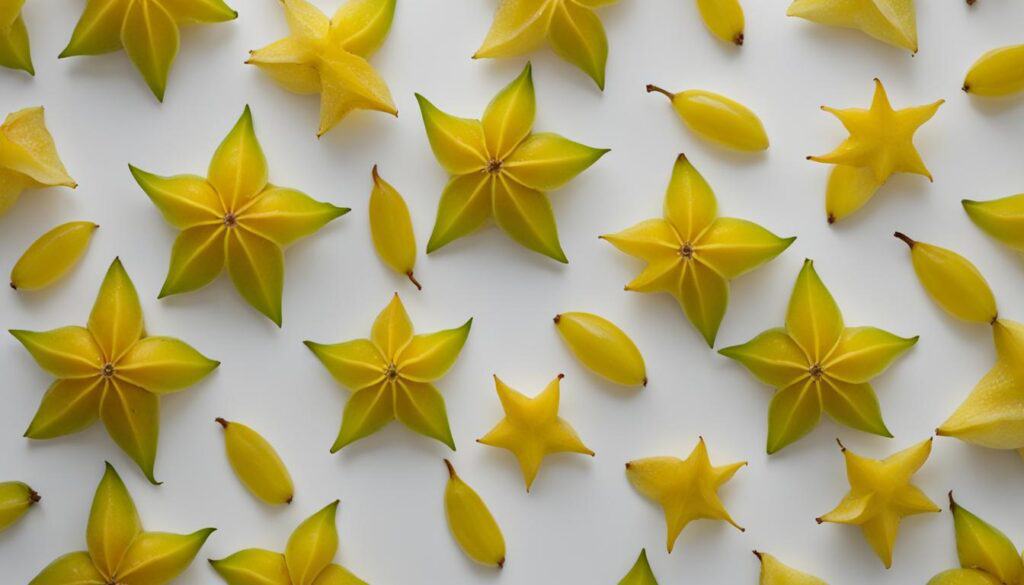
How to Cut Star Fruit
Once you have selected a ripe star fruit, it’s time to learn how to cut it properly. By following these simple steps, you can easily slice star fruit and incorporate it into your favorite recipes or enjoy it on its own.
1. Start by setting up your cutting station. Place a cutting board on a stable surface and make sure you have a sharp knife handy.
2. Choose a ripe star fruit that is bright yellow with hints of green. This indicates that the fruit is at its peak ripeness and will be easier to slice.
3. Begin by cutting off the dark tip along the ridge of the star fruit. This will create a flat surface for stability while cutting.
4. Next, remove the stem end of the fruit by cutting it off. This part is usually tough and not pleasant to eat.
5. Now, you can slice the star fruit into thin or thick slices, depending on your preference. Use a sharp knife and apply gentle pressure to create clean, even slices.
6. If you encounter any seeds while slicing, simply remove them with the tip of your knife.
Now you have beautifully cut star fruit slices that can be used in salads, desserts, or enjoyed on their own. Get creative with your star fruit and explore the many delicious possibilities!
Tips for Cutting Star Fruit:
- Using a sharp knife will make the cutting process easier and help you achieve clean slices.
- If you’re unsure about the thickness of the slices, start with thinner slices and adjust as needed.
- Don’t forget to remove any seeds you come across while cutting. They are not pleasant to eat and can affect the texture of your dish.
- Store any leftover star fruit slices in an airtight container in the refrigerator to keep them fresh for later use.
- Experiment with different recipes and presentations to make the most of your beautifully cut star fruit.
Ways to Enjoy Star Fruit
Star fruit, with its unique shape and sweet-tart flavor, can be enjoyed in a variety of delicious ways. Whether you’re looking for a refreshing beverage, a zesty addition to your salad, or a tropical twist to your cooking, star fruit can be a versatile ingredient in your culinary adventures.
The Many Recipes of Star Fruit
If you’re a fan of fruity beverages, why not try making star fruit juice? Simply blend ripe star fruit with some water and a touch of honey or sugar for sweetness. You can also add other fruits like pineapple or mango for a tropical blend of flavors. This refreshing juice is perfect for sipping on a hot day or as a base for mocktails.
If you enjoy experimenting in the kitchen, star fruit can be a great addition to your cooking repertoire. Its tangy taste pairs well with both sweet and savory dishes. For a simple yet elegant dessert, try baking star fruit slices with a sprinkle of cinnamon and sugar. The heat will bring out its natural sweetness and create a caramelized crust.
| Star Fruit Recipe | Description |
|---|---|
| Star Fruit Salsa | A vibrant and tangy salsa made with diced star fruit, red onion, jalapeno, lime juice, and cilantro. Perfect as a topping for grilled fish or as a dip with tortilla chips. |
| Star Fruit Chutney | A flavorful condiment made by cooking star fruit with spices, sugar, and vinegar. It pairs well with grilled meats or as a spread on sandwiches. |
| Star Fruit Salad | A refreshing and colorful salad made with star fruit, mixed greens, strawberries, and a citrus vinaigrette. Sprinkle some nuts or cheese for added texture and flavor. |
If you’re looking to incorporate star fruit into your everyday meals, consider adding it to stir-fries or sautés. Its crisp texture and tangy flavor can complement a wide range of ingredients. Try cooking star fruit with shrimp, chicken, or tofu for a quick and flavorful weeknight dinner.
Star fruit adds a unique touch to any dish, whether it’s a zesty salsa, a tropical smoothie, or a tangy stir-fry. Its versatility allows you to get creative in the kitchen and explore new flavors.
With its vibrant color and refreshing taste, star fruit can elevate any meal or snack. So the next time you come across this tropical fruit, don’t hesitate to try out some new star fruit recipes and discover the culinary possibilities it offers. Happy cooking!
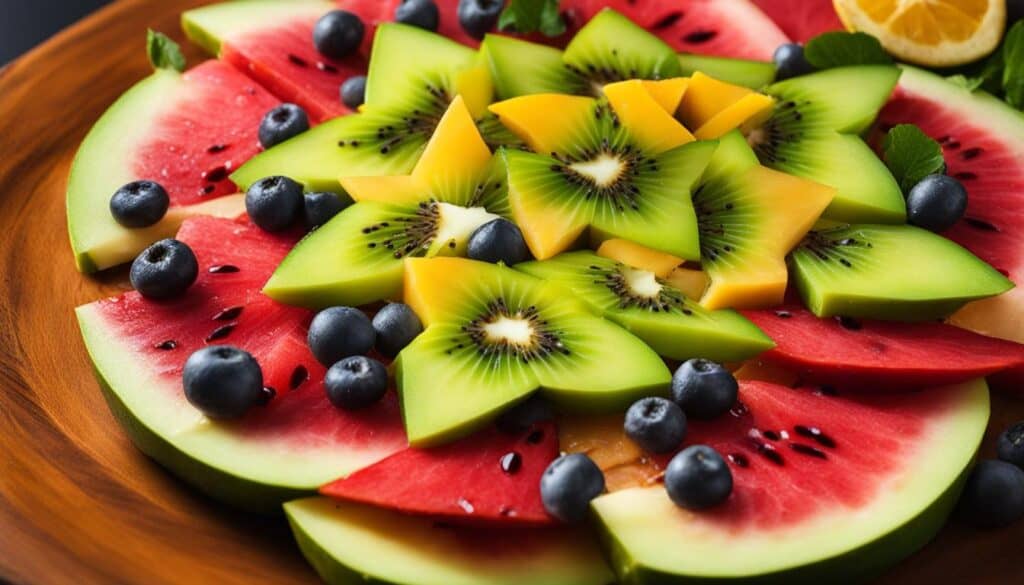
Health Benefits of Star Fruit
Star fruit is not only delicious, but it also offers numerous health benefits. Packed with essential nutrients, this tropical fruit can contribute to your overall well-being. Here are some of the key health benefits of star fruit:
Nutritional Value of Star Fruit
Star fruit is low in calories but rich in important vitamins and minerals. It is particularly high in vitamin C, an antioxidant that helps strengthen the immune system and promotes healthy skin. Additionally, star fruit is a good source of dietary fiber, which aids in digestion and helps maintain a healthy weight. It also contains small amounts of potassium, calcium, and iron.
| Nutrient | Amount per 100g of Star Fruit |
|---|---|
| Calories | 31 |
| Protein | 1g |
| Fat | 0g |
| Carbohydrates | 6g |
| Dietary Fiber | 2g |
| Vitamin C | 36mg |
| Potassium | 133mg |
| Calcium | 3mg |
| Iron | 0.08mg |
These nutritional values are approximate and can vary depending on the size and ripeness of the star fruit.
Antioxidant Properties
Star fruit contains powerful antioxidants that help protect your body against free radicals, which are unstable molecules that can cause damage to cells. The antioxidants in star fruit, such as vitamin C and flavonoids, can neutralize these harmful molecules and contribute to overall health and well-being.
Supports Digestive Health
The dietary fiber found in star fruit can help promote a healthy digestive system. Fiber adds bulk to your stool, making it easier to pass and preventing constipation. It also supports the growth of beneficial bacteria in your gut, which can enhance digestion and nutrient absorption.
May Promote Heart Health
Star fruit is low in sodium and high in potassium, which is a winning combination for heart health. A diet low in sodium and high in potassium can help lower blood pressure and reduce the risk of heart disease. Additionally, the antioxidants in star fruit may help reduce inflammation and improve the health of blood vessels.
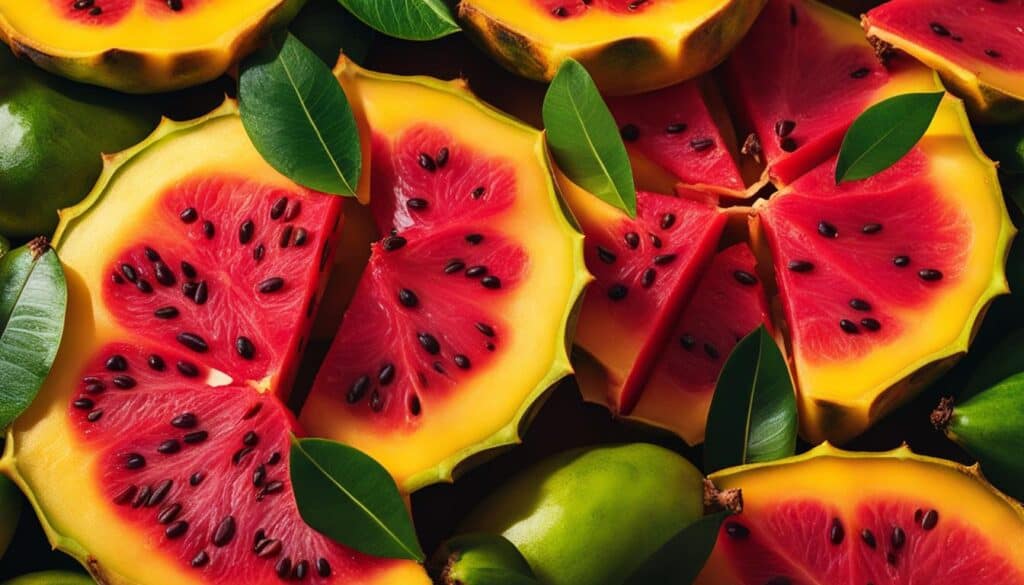
Where to Find Star Fruit
Are you eager to try star fruit but not sure where to find it? Look no further! Star fruit can be found in various locations, making it accessible to fruit enthusiasts around the world.
If you’re in warm weather regions such as Thailand, Southeast Asia, Australia, South America, Hawaii, or Florida, you can find star fruit at local grocery stores, markets, and farmer’s markets year-round. These regions are known for their abundance of tropical fruits, and star fruit is no exception.
If you’re located in other parts of the world, don’t worry! Specialty stores, such as Asian markets, often carry star fruit. These stores cater to a diverse range of customers and provide a wide selection of ingredients for various cuisines. So, be sure to check out your nearest Asian market for your star fruit fix.
Online options for finding star fruit
If you’re having trouble finding star fruit locally, consider exploring online options. Many online retailers and specialty fruit vendors offer star fruit for purchase. This option is especially convenient for those in areas where fresh star fruit may be harder to come by.
When buying star fruit online, be sure to check customer reviews and ratings to ensure you’re getting a quality product. Look for reputable sellers who prioritize freshness and customer satisfaction. By doing so, you can enjoy the taste of star fruit no matter where you are.
So, whether you prefer to shop locally or take advantage of online convenience, finding star fruit is easier than you think. With its unique flavor and versatility, star fruit is definitely worth seeking out to add a tropical twist to your culinary adventures.
How to Store Star Fruit
Proper storage of star fruit is essential to keep it fresh and flavorful for longer. Whether you’ve bought a ripe star fruit or want to extend its shelf life, here are some tips to store star fruit:
- Room Temperature: If the star fruit is not yet ripe, store it at room temperature on your kitchen counter. This will allow it to ripen gradually and develop its sweet flavor.
- Refrigeration: If you have a ripe star fruit and want to keep it fresh for a few more days, you can store it in the refrigerator. However, keep in mind that refrigeration may affect the texture and flavor of the fruit.
- Separation: When storing star fruit in the refrigerator, it’s best to keep it separate from other fruits and vegetables. Star fruit has a delicate flavor that can easily absorb strong odors, so storing it separately will help preserve its taste.
Remember to consume star fruit within a few days of refrigeration for optimal freshness and taste. If you have excess star fruit that you can’t consume in time, consider freezing it for later use in smoothies or desserts. Simply slice the fruit and store it in an airtight container or freezer bag.
Table: Star Fruit Storage Tips
| Storage Method | Temperature | Duration |
|---|---|---|
| Room Temperature | 70°F (21°C) | Ripening |
| Refrigeration | 40°F (4°C) | Up to 3 days |
| Freezing | -0°F (-18°C) | Up to 6 months |
By following these storage tips, you can enjoy the fresh and juicy taste of star fruit for longer, ensuring that it stays at its best until you’re ready to enjoy it.
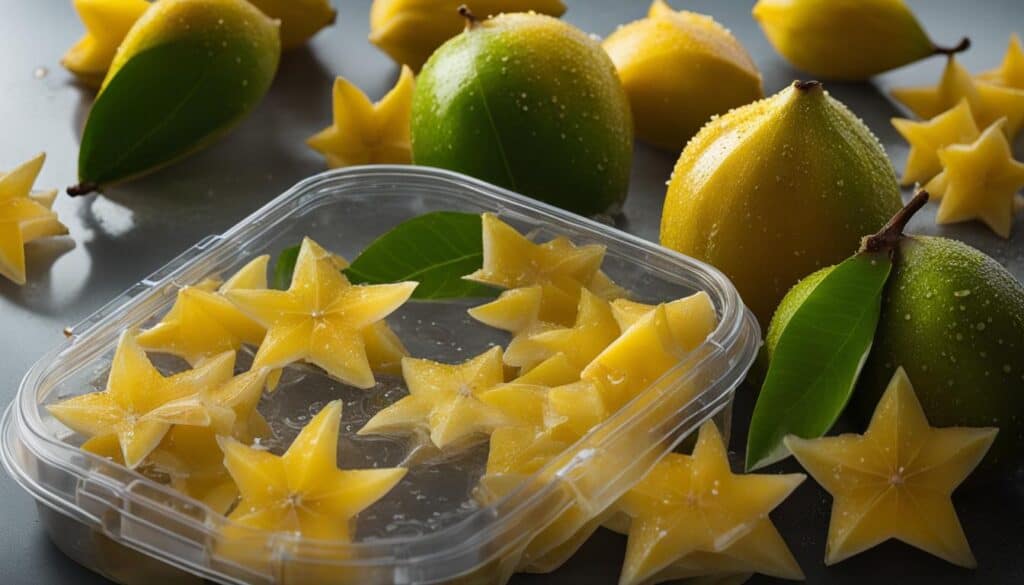
Star Fruit in Different Cultures
Star fruit, also known as Carambola, is a versatile fruit that is used in various cuisines around the world. Its unique shape and tropical flavor make it an excellent addition to both sweet and savory dishes. Let’s explore how different cultures incorporate star fruit into their culinary traditions.
Asian Cuisines
In Asian cuisines, particularly in Thai and Vietnamese cooking, star fruit is commonly used in both fresh and cooked dishes. It adds a refreshing and tangy flavor to salads, stir-fries, and seafood dishes. The star fruit’s natural sweetness complements the spiciness of certain Thai and Vietnamese curries, creating a balanced and flavorful combination. Star fruit is also often used as a garnish for drinks and desserts, adding a touch of elegance to the presentation.
Caribbean Delights
In the Caribbean, star fruit is a popular ingredient in drinks and desserts. It is commonly juiced and mixed with other tropical fruits to create refreshing beverages. The sweet and tart flavor of star fruit pairs well with rum-based cocktails, providing a tropical twist. In desserts, star fruit can be used to enhance the flavor of cakes, pies, and tarts. Its distinct shape and vibrant color make it an eye-catching garnish for desserts, adding visual appeal to the final presentation.
Indian Delicacies
In India, star fruit is used in various ways, particularly in the southern region. It is often included in curries, chutneys, and pickles, adding a subtle tangy flavor to the dishes. The star fruit’s crisp texture and mild sweetness complement the spices used in Indian cuisine, creating a harmonious blend of flavors. In addition to savory dishes, star fruit is also incorporated into traditional Indian desserts, such as jams, jellies, and fruit-based sweets.
| Cuisine | Preparation | Common Dishes |
|---|---|---|
| Asian | Fresh, cooked, garnish | Salads, stir-fries, curries, drinks, desserts |
| Caribbean | Juiced, desserts, garnish | Cocktails, cakes, pies, tarts |
| Indian | Curries, chutneys, pickles, desserts | Indian curries, jams, jellies, sweets |
As shown in the table above, different cultures have unique ways of incorporating star fruit into their cuisine. From Asian stir-fries to Caribbean cocktails and Indian curries, star fruit offers a delightful burst of flavor and adds a visually appealing touch to dishes. Exploring these diverse culinary traditions allows us to appreciate the versatility of star fruit and the creativity of different cultures in using this tropical fruit in their dishes.
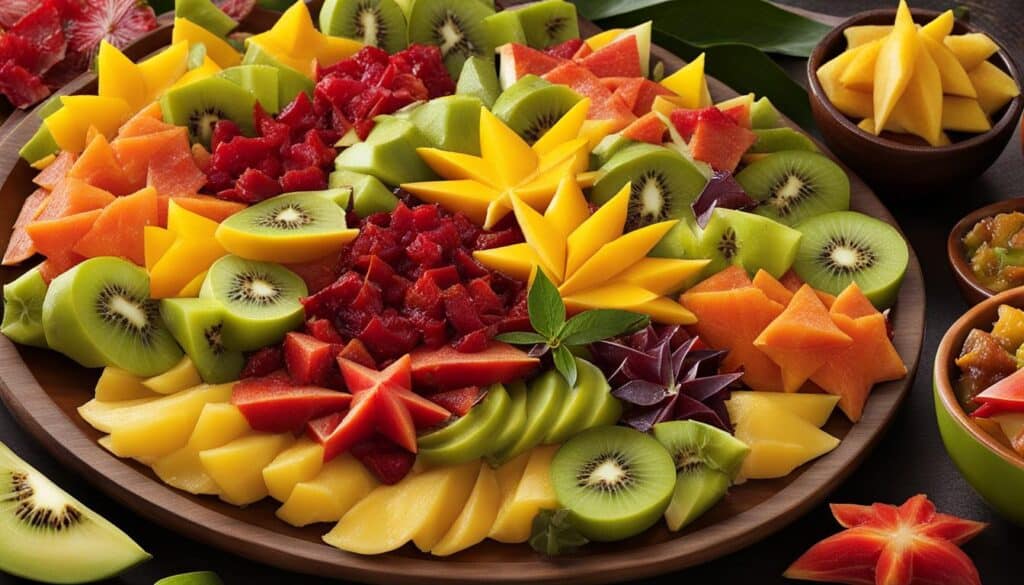
Conclusion
In conclusion, star fruit is a delightful tropical fruit that offers a mix of sweet and tart flavors. It is not only a tasty treat but also a rich source of antioxidants, fiber, and vitamins. Adding star fruit to your diet can benefit your overall health.
Whether you enjoy it fresh, incorporate it into your favorite recipes, or use it to make refreshing juices, star fruit brings a unique and exotic touch to any dish. Its versatility and vibrant appearance make it an appealing addition to both sweet and savory preparations.
So, next time you’re at the grocery store, don’t forget to grab some star fruit and explore the wonderful flavors it has to offer. Its tropical taste and nutritional benefits are sure to make it a favorite in your kitchen. Give star fruit a try and let it brighten up your culinary adventures!
FAQ
When is star fruit ripe?
When ripe, star fruit is bright yellow with hints of green and may have brown spots along the ridges. The flesh should be firm to the touch. Overripe star fruit turns entirely yellow with brown spots.
What is star fruit?
Starfruit, also known as Carambola, is a juicy tropical fruit grown in Thailand, Southeast Asia, Australia, South America, Hawaii, and Florida. It is a part of the citrus family and comes in two main varieties: sour and sweet.
How do you choose ripe star fruit?
When choosing star fruit, look for bright yellow with hints of green. The ridges may have some brown spots, which is normal. Avoid star fruit that is mostly green as it may be too sour. If you can only find green star fruit, you can ripen it by leaving it on the counter for a few days until it turns yellow. A ripe star fruit should be firm to the touch.
How do you cut star fruit?
To cut star fruit, start by setting up your cutting station with a cutting board and a sharp knife. Pick a ripe star fruit that is bright yellow with hints of green. Cut off the dark tip along the ridge and the stem end of the fruit. Slice the star fruit into thin or thick slices, depending on your preference. Remove any seeds with the tip of the knife. The slices can be used in salads, desserts, or enjoyed on their own.
How can star fruit be enjoyed?
Star fruit can be eaten fresh as a snack or added to smoothies and salads. It can also be used to make juice, relishes, pickles, and preserves. Some cultures even use star fruit in curries and other savory dishes. It can also be baked into desserts. The versatility of star fruit allows for creative experimentation in the kitchen.
What are the health benefits of star fruit?
Star fruit is a great source of antioxidants, fiber, and vitamins. It can help lower cholesterol levels, reduce inflammation, and support blood sugar balance. However, people with kidney problems or those on certain medications should consult with a doctor before consuming star fruit.
Where can star fruit be found?
Star fruit is commonly found at local grocery stores, markets, and farmer’s markets. It is available year-round and can be easily found in warm weather regions. Specialty stores, such as Asian markets, often carry star fruit as well. If you’re having trouble finding star fruit, consider checking online or exploring stores known for carrying tropical fruits.
How should star fruit be stored?
To keep star fruit fresh, store it at room temperature on your kitchen counter. If the fruit is ripe and you want to extend its shelf life, you can store it in the refrigerator. However, refrigeration may affect the texture and flavor of the fruit, so it is best to consume it within a few days. Avoid storing star fruit near strong-smelling foods as it can absorb odors.
How is star fruit used in different cultures?
Star fruit is used in various cuisines and dishes around the world. It is commonly used in Asian cuisines, such as Thai and Vietnamese, in both sweet and savory preparations. In the Caribbean, it is often used in drinks and desserts. In India, it is used in curries and chutneys. Exploring different cultural recipes can provide a unique and diverse culinary experience with star fruit.

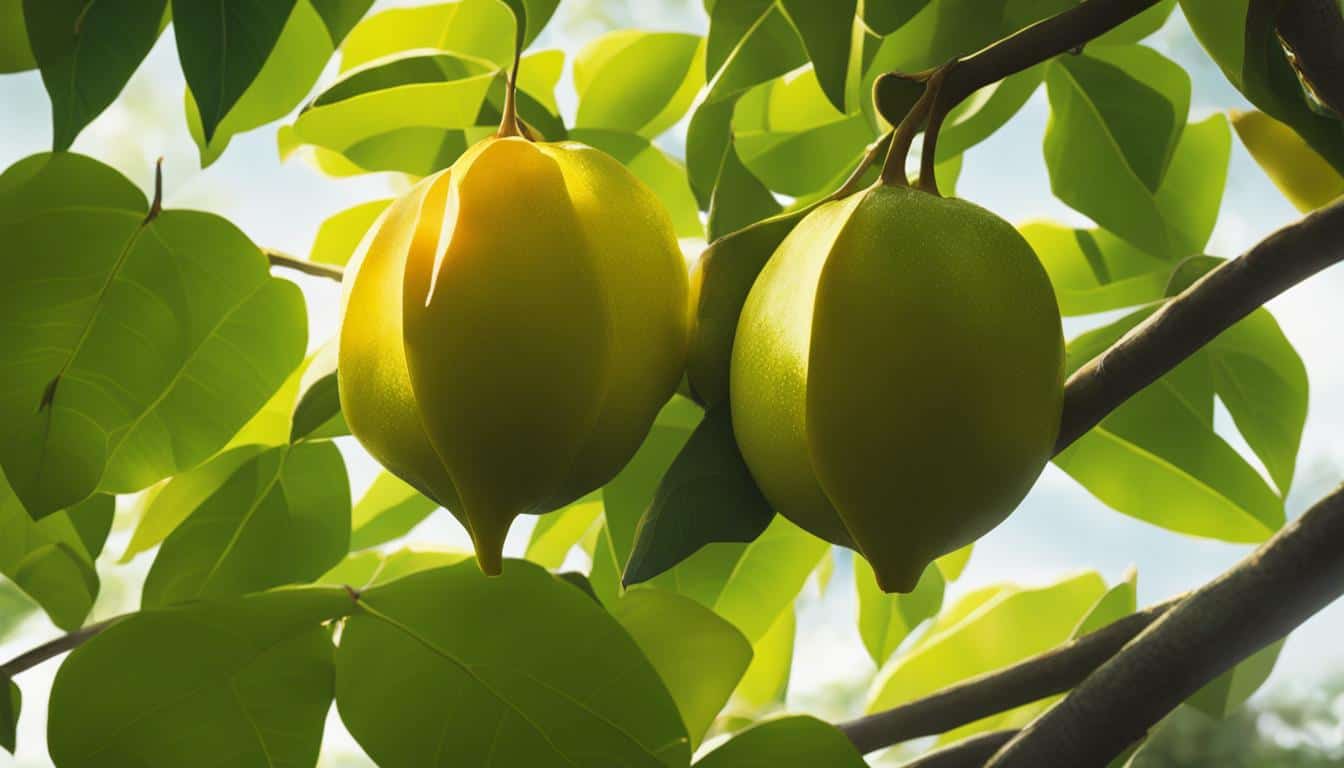



Leave a Reply